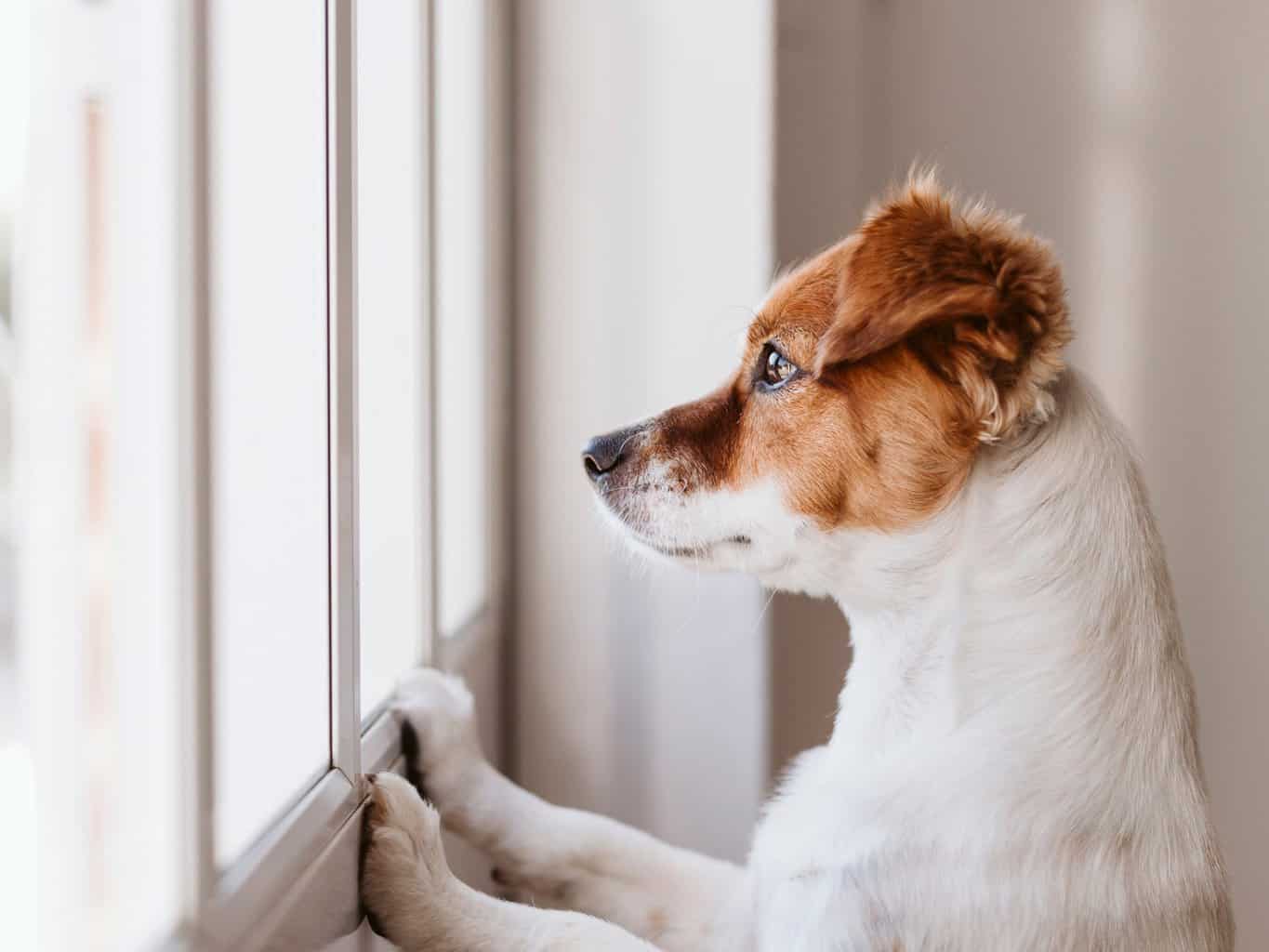How to Stop a Dog’s Separation Anxiety

Many dogs suffering from separation anxiety become stressed from separation from their pet parents, and anxiety is the result. You will find our list of ideas that will have a calming effect on dogs and help them to become happy and normal dog.
What is Dog Separation Anxiety?
Separation anxiety is a condition in which a dog experiences extreme anxiety when left alone. It is relatively common in dogs, and many develop it at some point in their lives. Separation anxiety can manifest in many ways, including barking, whining, howling, pacing, destructive behaviour, and even attempting to escape.
Separation anxiety is difficult to cure. Think of it like a panic attack in humans, and your dog has over-attached itself to you or a canine companion. Dog doesn’t like being left alone, and they suffer from stress and anxiety. Read on for some tips and advice to help them settle.
Dogs who have separation anxiety often become agitated when their owners prepare to leave them alone and may try to follow them or become highly anxious when they are crated.
How Do You Know if Your Dog has Separation Anxiety?
If you’re not sure if the dog is suffering from a case of separation anxiety or not, you can do a test. Leave your dog alone for a short period of time and see how they react. If they show signs of anxiety, such as pacing, panting, whining, or barking, they may have separation anxiety.
Some dogs are just pre-disposed to suffering from it, while for others, a change to their normal routine can start it off; anxious dogs, old dogs or young dogs might exhibit signs when any of these events happen:
What Causes of Separation Anxiety?
It is not just that you’re not at home there are sometimes triggers that make your dog start to worry about being left.
Your Dog Struggles With?
- Changes in routines
- Holidays
- Being left for long periods
- Moving to a new home
- New baby
- New pet
What Are the Signs of Separation Anxiety in Dogs?
A change in routine often causes separation anxiety, does your dog exhibits any of these signs, either when you are getting ready to leave or return home and find a dog that’s distressed with any of these behaviours?
Dogs react differently, but just one of these could be a sign that your dog is suffering:
- Whining
- Destructive behaviour, chewing on objects
- Chewing on own skin
- Howling
- Trembling,
- Incessant barking
- Pacing Frantically
- Urinating or defecating indoors
What Can I Do About My Dog’s Separation Anxiety?
Dealing with separation anxiety is a common problem and tough to deal with. Dogs can develop it, but it doesn’t have to be permanent. You can do things to help your dog feel more comfortable and confident when you’re not around.
Take your dog from being anxious to being confident by following the advice in this article.
Dog training can be a great way to help your dog learn how to cope with separation anxiety. Your dog must enjoy it and you will need plenty of patience and consistency, you can help your dog become a happy, well-adjusted dog who loves spending time away from you.
Tips to Help Ease Dog Separation Anxiety
It’s essential to be patient and consistent with training. Teach your dog that being left alone doesn’t have to be bad by offering positive reinforcement when they’re calm and relaxed. Even if dogs develop, mild separation anxiety can be stressful for both owner and dog.
Could it be something else?
Before anything else, rule out other possible causes, such as illness, boredom, lack of exercise, or hunger. All of these problems could be similar to signs of separation anxiety. Make sure you tick all these boxes before considering a more complex issue.
Exercise
One way to help your dog learn to be calm is to take them for walks. This gives him a chance to burn off energy and explore his surroundings. Leave your dog at home when you know you’ll be gone for a long time or if there’s going to be a lot of activity in the house. This will help your dog feel more relaxed and less stressed. A tired dog is normally a happy and sleepy dog.
Food
Leave your dog with a full stomach. A hungry dog is more likely to become anxious and stressed when left alone, so making sure they have a good meal before you go is essential.
Invest in Quality Toys & Treats
Mental Stimulation for your dog. Find ‘home-alone’ toys and treats, long-lasting chews, and puzzles that take a while for them to solve. Make sure they are unique and are only given to them when you are going out. Give them something to get excited about, distracted and be less worried about the time you leave.
Provide a view of the outdoors for them. Your dog could suffer from a condition often mistaken for separation anxiety – boredom!
Dog Crates
Dogs can benefit from being crate-trained. That’s an excellent place to start. Some dogs feel safer in crates, and being left alone for short periods can help them get used to being away from you.
Crates can help your dog get better separation anxiety and ensure it is safe when you can’t supervise them. Dogs tend to like having their own space, and a crate provides that. Set up a safe confinement zone for your dog by putting a crate in a quiet area of your house where your dog can feel comfortable and relaxed.
The crate will give them a safe space to go to when you leave the house and help ease their anxiety. You must want your dog to enjoy going into the crate and see it as a safe place, not somewhere they will be punished. You can do this by giving them treats or toys in their crate and ensuring they have a comfortable bed.
Best Reviewed Dog Crate – iCrate
Click here to see the listing – https://amzn.to/3DHtptl
Remember, not all dogs enjoy going into a crate. If your dog takes a dislike to the crate, do not force them; if you can’t tempt them in with some of their favourite toys and treat, try to feed them in there, but DO NOT close the crate door in the beginning, give them time and space to get used to it.
You can also buy covers to go over the crate. This can make it feel more natural and ‘den-like’; they may prefer this option, check out our top pick here – https://amzn.to/3BUa2Me
If your dog just doesn’t get on with the crate, other options exist to make them feel safe and secure; it might be a room or the run of the house. You know your dog better than anyone else, so watch their behaviour closely.
Make sure your dog is happy with the crate before leaving them in it all day. You can also look into playpens that can attach to the crate to give them some room to play.
Your dog may prefer the run of the house, and if it can be trusted, this is a great option. Access to windows, toys and puzzles can be a great way to help your dog feel more confident and happy about being left.
Sleep
If you have your dog in bed with you at night. It’s time to stop; of course, you can still have snuggle time in the mornings and evenings, but when it’s time for sleep, they must learn to sleep alone.
If they enjoy their crate and you have covered it to make it like a den, this would be a perfect place to sleep; look below, and donut beds; these are great for making them feel like a safe and happy dog.
Top Pick Donut Beds
Best Friends Luxury Calming Small Donut – https://amzn.to/3dpBuby
Best Friends Luxury Calming Medium Donut – https://amzn.to/3R0DXGM
Comfort
Help your dog suffering from separation anxiety by leaving a worn item of your clothing for them to sleep with. You can also try and place it on the other side of the door, making them feel closer to you and not so far away.
Stop the Triggers
If your dog begins to notice and worry about the triggers, turn putting on your coat, picking up a purse or bag, and pick up your keys all into neutral events for your dog, by preparing to leave but not leaving the house. In time your dog becomes less sensitive to the triggers and it will lose its power to generate fear.
Another way to help a dog with separation anxiety is to get used to your comings and goings. If you usually leave through the front door, try going out the back. Or, if you always put on your coat before leaving, try doing something else first. This will help your dog see nothing unusual about you going and coming back.
Build Up Their Confidence
Start small and ensure your dog gets the best chance of not worrying. Build their confidence slowly; practice, ask your dog to stay, sit, down, and wait (whatever works in your training) while you leave the room for just a moment. Make sure that your dog on the other side of a closed door inside the home for short periods each day.
Keep on working on this, don’t skip this step. Their confidence when the dog is alone could be the key to resolve the dog’s underlying anxiety or help reduce dog anxiety.
Help your dog feel comfortable being left alone by gradually building up the amount of time he’s alone. Start with just a few minutes and work up to more extended periods. This will help your dog feel more confident and secure when left alone.
Going out
Don’t make a big fuss; get ready to go and say goodbye to your dog in a calm voice.
Coming Home
Be boring when you come home. Try to greet your dog after they have calmed down and the dog isn’t too over-excited.
You can help your dog’s underlying anxiety by teaching them to enjoy being left alone with patience and effort. You will know when your dog is ready to start being left for longer periods.
What Not to Do
Leaving your dog to ‘cry it out’ means suffering in silence. It is a form of dog training where the dog is left alone for a specific period until it becomes quiet. This can be very stressful for the dog and cause them to become anxious and depressed.
Many dogs have anxiety when you’re out, which can mean that the dog gets bored and frustrated. Punishment won’t help a dog learn how to behave better – it will just make them scared of you. Dogs need patience, love and positive reinforcement to learn how to be well-behaved.
If your dog has separation anxiety, it’s important not to punish them. This will only worsen the problem and cause your dog to become even more anxious. Instead, try to work on gradually acclimating your dog to being away from you. This may take time and patience, but it will be worth it in the end.
Punishing your dog for having separation anxiety will only make the problem worse. Instead, give your dog plenty of love and attention when you’re home, and provide him with toys and bones to keep him occupied when you’re gone.
These tips may not be enough if your dog has severe separation anxiety. In this case, it’s vital to seek professional help from a qualified behaviourist or trainer who can
How long can my dog be left alone?
A dog should never be left alone for more than a few hours. If you must leave your dog alone for extended periods, ensure they have plenty of food, water, and a comfortable place to sleep.
If you’re not home and leave them for 5+ hours daily, you want to consider a dog walker. They range in local areas, but having someone come in and take them out, will help with your dog’s anxiety, give them something to look forward to, and make you feel less guilty when you’re not home.
Is medication necessary for treating separation anxiety in dogs?
There are other options that can help dogs, medication, behaviour modification, and training. Talk to your veterinarian or a local dog trainer about the best treatment options if you think your dog may have separation anxiety.
After the holidays: getting your dog back into your normal routine
After the holidays, getting your dog back into its routine is essential. This will help your dog adjust and feel more comfortable. Time your dog accordingly, and be sure to help them out if they need it
Resources and products to help with separation anxiety
Many resources and products are available to help with separation anxiety in dogs. These products include thunder shirts, calming collars, and anti-anxiety medication.





